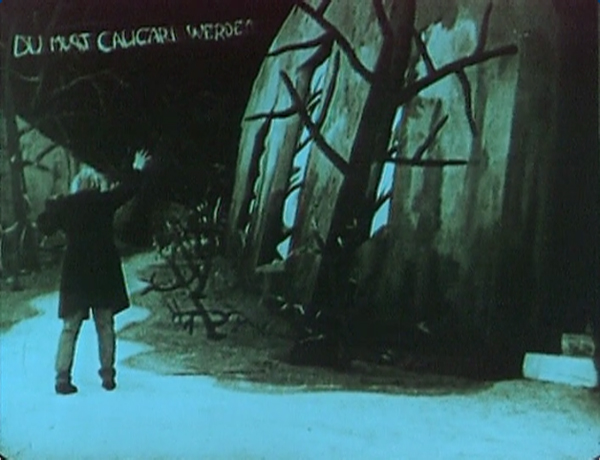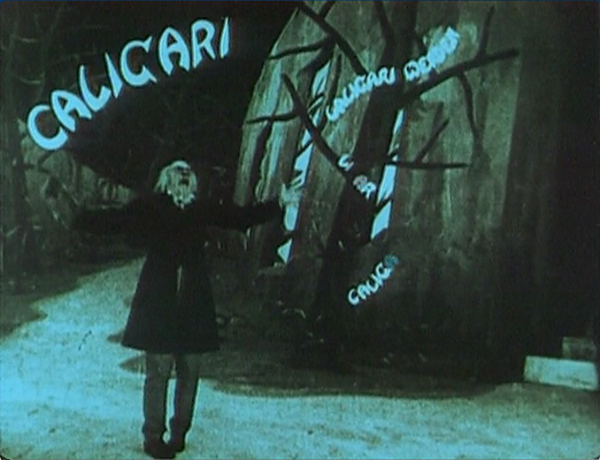|
The Cabinet of Dr. Caligari (1919) presents one of the earliest examples of kinetic typography integrated into the dramatic action, functioning within the narrative �space� of a fiction film in a way that is clearly distinct from the more prosaic applications�such as a character reading a letter where the letter itself is shown to the audience�Caligari�s reaction to the appearance of the typography within the visual space of the climactic scene is a highly unusual moment in an already unusually experimental feature. The use of diegetic and non-diegetic type is extremely common in the �silent� era film precisely because it did not have the technical capacity for synchronous sound; however, the typography in The Cabinet of Dr. Caligari is of a different character entirely than those commonly used. It appears in the film not in the form of a letter or book, but as a visualization of madness�as the dramatization of the film�s climax.

The moment comes at a crucial point in the film, literally the central discovery at the heart of the drama: the head doctor, the man running the insane asylum, is himself insane. Cesare has been brought in, the doctor has recognized him as a somnambulist, and runs from his office; outside, literally written around him on the trees and the curving wall next to the path are the words �Du Musst Caligari Werde� (You Must Become Caligari). The language is mapped onto the tree trunks branches, appearing letter by letter in a stop-animation process. It is historically exceptional, and integrations of type within the fictional narratives remained uncommon until digital technology fundamentally altered the production process.


This early example of kinetic type was produced using an innovative combination of techniques that would become one of the two most common methods for titling by the 1930s, and which would remain in use until digital technology completely altered the production process in the 1990s: using the photographic shots of the scene for reference, the type was shot with an animation stand, with the lettering registered to the photograph, and animated into the shot using the standard single frame technique. This shot of white (clear film) typography against a black background was then superimposed over the photographic shot during the printing process�in the answer print, the type shows up white (as overexposed film) within the scene. It is fundamentally a special effects shot where the special effect is the typography appearing on screen. Because the actor, Werner Krauss (Dr. Caligari), responds to the type, the illusion of its presence is complete. It is the external projection of his madness, the visual enactment shows his excitement at the arrival of Cesare leads not to the grand scientific discovery, but through the doors of madness. This typography appears to both the doctor and to the audience, but it is simultaneously apparent to the viewer that these words are a hallucination, a mental projection onto the world around him, much as the distorted sets and design suggest a contorted and unstable reality.
|

|